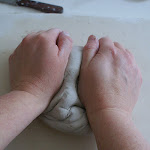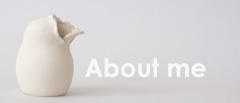Making a mould is not difficult, it's just a bit messy so you better have everything you need prepared beforehand.
This is what you need: plaster, empty icecream containers, liquid beeswax, clay, scissors, knife, doublesided tape, tape, modelling materials (only if you mould claywork), plasterlocks, paintbrush, water, towel. Be sure to protect your surface with a plastic tablecloth and wear an appron if you're messy.
 The most important thing when you make a double mould is marking the exact middle of the object you want to mould.
The most important thing when you make a double mould is marking the exact middle of the object you want to mould. Make a little bed for the object to lay in. I do that by rolling out a piece of clay and draping it around the object.
Make a little bed for the object to lay in. I do that by rolling out a piece of clay and draping it around the object. Then you need to make sure that it closes tight to the marking line by adding clay and making sure that no plaster can go underneath.
Then you need to make sure that it closes tight to the marking line by adding clay and making sure that no plaster can go underneath. It's a very precise task and it always takes me ages...
It's a very precise task and it always takes me ages... Done! I'm satisfied with how it looks.
Done! I'm satisfied with how it looks. Now there are two ways to make the locks for the moulds. These are plastic ones that you press into the sides. The advantage is that they make the mould more durable. So if you are going to use it often, I advise you to buy some of these.
Now there are two ways to make the locks for the moulds. These are plastic ones that you press into the sides. The advantage is that they make the mould more durable. So if you are going to use it often, I advise you to buy some of these. The second way is to press a round object into the sides of the object. Plaster will go into those and will give you a bump.
The second way is to press a round object into the sides of the object. Plaster will go into those and will give you a bump. I will use the mould a lot so I chose to work with the plastic locks.
I will use the mould a lot so I chose to work with the plastic locks. Build with plastic a tower around the clay and make sure that there is enough clay on the bottom so no plaster can escape.
Build with plastic a tower around the clay and make sure that there is enough clay on the bottom so no plaster can escape. Pour the plaster into the construction and let it set.
Pour the plaster into the construction and let it set. After about an hour, I open up the construction and you see this...
After about an hour, I open up the construction and you see this... Take away the little clay bed you made around the object.
Take away the little clay bed you made around the object. Then make sure that the object looks all nice and happy again. You can do that by smoothening it with a credit card or a slightly wet brush.
Then make sure that the object looks all nice and happy again. You can do that by smoothening it with a credit card or a slightly wet brush. As I didn't do a very good job on the plastic slots, I decided to add some extra clay around it. It won't matter for the result of the mould.
As I didn't do a very good job on the plastic slots, I decided to add some extra clay around it. It won't matter for the result of the mould. Since you'll be pouring plaster onto plaster, you will need to add liquid beeswax onto the plaster.
Since you'll be pouring plaster onto plaster, you will need to add liquid beeswax onto the plaster. Build the little construction again and fill it with plaster.
Build the little construction again and fill it with plaster. After about an hour, this is the result.
After about an hour, this is the result. Oh, and the object is a full lump of clay - it's not hollow inside as the pressure from the plaster would make it go all wonky.
Oh, and the object is a full lump of clay - it's not hollow inside as the pressure from the plaster would make it go all wonky. The mould will need to dry very well before you can use it. I put it on the radiator.
The mould will need to dry very well before you can use it. I put it on the radiator.It will be great for much future fun! :)
Enjoy moulding if you start and if you have any questions, please don't hesitate to contact me.









